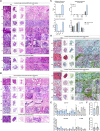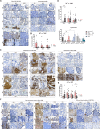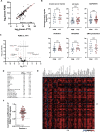Breast cancer patient-derived microtumors resemble tumor heterogeneity and enable protein-based stratification and functional validation of individualized drug treatment
- PMID: 37596623
- PMCID: PMC10436441
- DOI: 10.1186/s13046-023-02782-2
Breast cancer patient-derived microtumors resemble tumor heterogeneity and enable protein-based stratification and functional validation of individualized drug treatment
Abstract
Despite tremendous progress in deciphering breast cancer at the genomic level, the pronounced intra- and intertumoral heterogeneity remains a major obstacle to the advancement of novel and more effective treatment approaches. Frequent treatment failure and the development of treatment resistance highlight the need for patient-derived tumor models that reflect the individual tumors of breast cancer patients and allow a comprehensive analyses and parallel functional validation of individualized and therapeutically targetable vulnerabilities in protein signal transduction pathways. Here, we introduce the generation and application of breast cancer patient-derived 3D microtumors (BC-PDMs). Residual fresh tumor tissue specimens were collected from n = 102 patients diagnosed with breast cancer and subjected to BC-PDM isolation. BC-PDMs retained histopathological characteristics, and extracellular matrix (ECM) components together with key protein signaling pathway signatures of the corresponding primary tumor tissue. Accordingly, BC-PDMs reflect the inter- and intratumoral heterogeneity of breast cancer and its key signal transduction properties. DigiWest®-based protein expression profiling of identified treatment responder and non-responder BC-PDMs enabled the identification of potential resistance and sensitivity markers of individual drug treatments, including markers previously associated with treatment response and yet undescribed proteins. The combination of individualized drug testing with comprehensive protein profiling analyses of BC-PDMs may provide a valuable complement for personalized treatment stratification and response prediction for breast cancer.
Keywords: Anti-cancer drug efficacy; Breast cancer; Preclinical tumor model; Protein profiling; Therapy resistance; Therapy sensitivity; Tumor heterogeneity.
© 2023. Italian National Cancer Institute ‘Regina Elena’.
Conflict of interest statement
A.H. received consulting and speaking fees from AstraZeneca, Amgen, Clovis, Daichii Synkyo, Eisai, ExactScience, Gilead, GSK, Hexal, Lilly, MSD, Novartis, Pfizer, Roche, Pierre-Fabre and Seagen. N.A., F.S-R., N.K, A.K., A.-L.K., B.G., A.S., S.L., M.P., M.H., S.Y.B., K.S-L., M.T. and C.S. declare no competing interest.
Figures






Similar articles
-
A Platform of Patient-Derived Microtumors Identifies Individual Treatment Responses and Therapeutic Vulnerabilities in Ovarian Cancer.Cancers (Basel). 2022 Jun 12;14(12):2895. doi: 10.3390/cancers14122895. Cancers (Basel). 2022. PMID: 35740561 Free PMC article.
-
Breast cancer patient-derived whole-tumor cell culture model for efficient drug profiling and treatment response prediction.Proc Natl Acad Sci U S A. 2023 Jan 3;120(1):e2209856120. doi: 10.1073/pnas.2209856120. Epub 2022 Dec 27. Proc Natl Acad Sci U S A. 2023. PMID: 36574653 Free PMC article.
-
Targeting the MAPK signaling pathway: implications and prospects of flavonoids in 3P medicine as modulators of cancer cell plasticity and therapeutic resistance in breast cancer patients.EPMA J. 2025 Apr 10;16(2):437-463. doi: 10.1007/s13167-025-00407-6. eCollection 2025 Jun. EPMA J. 2025. PMID: 40438489 Free PMC article.
-
The next generation personalized models to screen hidden layers of breast cancer tumorigenicity.Breast Cancer Res Treat. 2019 Jun;175(2):277-286. doi: 10.1007/s10549-019-05159-2. Epub 2019 Feb 27. Breast Cancer Res Treat. 2019. PMID: 30810866 Review.
-
Molecular characterization and targeted therapeutic approaches in breast cancer.Breast Cancer Res. 2015 Apr 23;17(1):60. doi: 10.1186/s13058-015-0560-9. Breast Cancer Res. 2015. PMID: 25902832 Free PMC article. Review.
Cited by
-
Genome-wide CRISPR-Cas9 screens identify BCL family members as modulators of response to regorafenib in experimental glioma.Neuro Oncol. 2025 May 15;27(4):916-931. doi: 10.1093/neuonc/noae278. Neuro Oncol. 2025. PMID: 39756423 Free PMC article.
References
-
- Lakhani SR, Ellis IO, Schnitt S, Tan PH, van de Vijver M. WHO Classification of Tumours of the Breast. 2012.
-
- Tavassoli F.A. & Devilee P. Pathology and Genetics of Tumours of the Breast and Female Genital Organs. WHO Classification of Tumours. IARCPress Lyon. 2003, 246.
-
- Perou CM, Sørlie T, Eisen MB, Van De Rijn M, Jeffrey SS, Rees CA, et al. Molecular portraits of human breast tumours. Nature. 2000;406(6797):747–752. - PubMed
MeSH terms
Grants and funding
LinkOut - more resources
Full Text Sources
Medical

